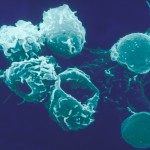Link to Pubmed [PMID] – 30475388
Allergy 2019;74:933-943
BACKGROUND: We previously showed that patients with severe allergic asthma have high numbers of circulating ILC2s expressing CCR10.
METHOD: Herein, CCR10 ILC2s were further analyzed in the blood of healthy individuals or patients with allergic and non-allergic asthma. Characteristics of human CCR10 and CCR10 ILC2s were assessed by flow cytometry as well as single-cell multiplex RT-qPCR. The role of CCR10 ILC2s in asthma pathophysiology was studied in allergen-treated mice.
RESULTS: When compared to healthy controls, CCR10 ILC2s are enriched in the blood of both allergic and non-allergic severe asthmatic patients, and these cells are recruited to the lungs. Plasma concentrations of the CCR10 ligand CCL27 are significantly increased in severe asthmatics when compared to non-asthmatic patients. CCR10 ILC2s secrete little T 2 cytokines, but exhibit ILC1-like properties, including a capacity to produce IFN-γ. Also, single-cell analysis reveals that the CCR10 ILC2 subset is enriched in cells expressing amphiregulin. CCR10 ILC2 depletion, as well as blocking of IFN-γ activity, exacerbates airway hyperreactivity in allergen-challenged mice, providing evidence for a protective role of these cells in allergic inflammation.
CONCLUSIONS: Frequencies of circulating CCR10 ILC2s and CCL27 plasma concentrations represent candidate markers of asthma severity. The characterization of CCR10 ILC2s in human samples and in mouse asthma models suggests that these cells downregulate allergic inflammation through IFN-γ production.


